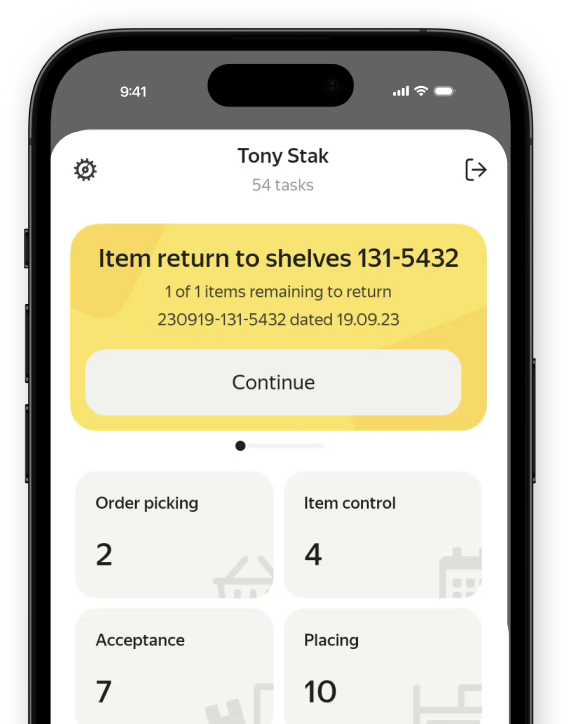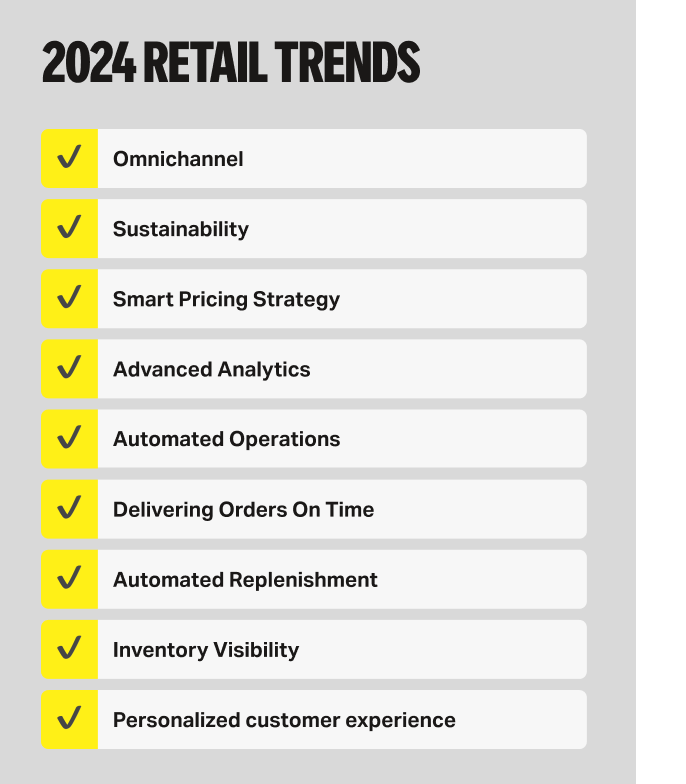Yango Tech and Surtifamiliar Partner for Next-Generation AI-Powered Grocery E-commerce in Colombia


The retail industry, long characterized by gradual evolution, now stands at the precipice of unprecedented change as we step into 2024. Consumer behaviors, once fairly predictable, have taken on novel and often volatile patterns, while technological innovations that were once on the periphery are now commanding the center stage of the market. In this comprehensive exploration, we delve into key retail trends that are reshaping the industry landscape and explore how businesses can successfully navigate this dynamic and ever-evolving terrain.
Gone are the days of separate online and offline shopping experiences. The emergence of omnichannel retailing marks a pivotal shift, seamlessly integrating the digital and physical spheres. This approach ensures a cohesive and consistent customer journey across various channels, be it through websites, mobile apps, or physical stores. The convergence of online and offline realms results in a unified shopping ecosystem where convenience and familiarity intertwine.
Consumers now expect a unified experience, whether they are browsing a website, using a mobile app, or walking through a physical store. This demands a comprehensive approach that goes beyond merely providing consistent product information, pricing, and quality across touchpoints. It requires advanced, multi-channel customer experiences, various possibilities for retention, precise sales forecasting, and optimization of unit economics. As online and offline channels seamlessly integrate, retailers must think of their operations as part of a unified shopping experience, ensuring growth, scalability, and an increase in margins.

Beyond the conventional pursuit of eco-friendly materials and packaging, today's consumers demand a deeper commitment to sustainability. Ethical sourcing practices, transparent supply chains, responsible waste management, and alignment with socially responsible values have become crucial considerations for the modern consumer. Embracing sustainability is not just a moral obligation; it has become a strategic advantage for retailers.
Local sourcing is gaining prominence not only for its positive impact on reducing the environmental footprint but also for its ability to build trust and foster community engagement. Governments worldwide are recognizing this shift and actively supporting the sustainable development of the digital economy. The expansion of internet penetration empowers consumers to make informed choices and encourages responsible e-commerce practices. This, in turn, incentivizes retailers to embrace local sourcing and establish strong partnerships with regional producers. The momentum for sustainability isn't confined to specific regions; it's a global trend driven by both consumer demand and government initiatives.
In the face of shifting consumer purchasing power, retailers are compelled to adopt intelligent pricing strategies. These strategies integrate automation, real-time insights, and user-friendly interfaces to enhance data quality, pricing accuracy, and overall business performance. An effective pricing strategy incorporates area-specific price sensitivity, adjusting prices based on geographical affluence to extract maximum revenue.
Automation in pricing execution, leveraging dynamic pricing algorithms, is essential for automating sales and reducing write-offs of pre-expired items. Artificial intelligence and machine learning technologies are actively involved in these algorithms, taking pricing strategies to new levels. Machine learning algorithms enhance pricing strategies by analyzing vast datasets, enabling precise price predictions, optimizing pricing rules, and adapting strategies to changing market conditions. An ideal pricing strategy is user-friendly, involving staff training for seamless implementation and ensuring frequent updates to align with evolving market needs.
Automated replenishment systems, powered by artificial intelligence, provide a solution to the perennial "out-of-stock" dilemma. By harnessing inventory data and sophisticated demand forecasting algorithms, these systems predict future needs and automatically initiate restocking orders. This proactive approach not only enhances customer satisfaction by ensuring optimal product availability but also streamlines operational efficiency, leading to reduced write-offs from expired products.
The advantages of automated replenishment extend beyond customer satisfaction to encompass improved operational efficiency and cost savings through optimized inventory levels. Keeping products available with Yango Tech’s Auto Replenishment Solution ensures the right amount of products, thereby improving sales and boosting profits. The visual representation of a low stock alert emphasizes the importance of staying ahead of inventory needs.

The magic behind many retail trends lies in data. Advanced analytics serves as the engine that drives insights, fuels optimization, and enables retailers to adapt to the ever-changing landscape. These analytics go beyond basic reporting, delving into complex areas such as predictive modeling, customer segmentation, and churn analysis.
Intelligent insights provided by analytics not only enable fast adaptation to trends but also ensure the sustainable operation of new algorithms. AI and machine learning algorithms analyze vast amounts of data, from customer interactions to sales transactions, identifying patterns and drawing actionable insights. This empowers retailers to personalize marketing campaigns, optimize pricing strategies, and predict future demand with greater accuracy. However, the successful implementation of advanced analytics requires not only the right technology but also a data-driven culture within the organization.
Traditional manual processes and fragmented systems are giving way to a more efficient era of automated retail operations. Powered by a sophisticated blend of personal digital terminals, advanced scanning technologies, intelligent robotic systems, and tightly integrated software suites, all orchestrated by machine learning algorithms, this trend is reshaping how retailers function.
Smart warehouse topology, enabled by AI, optimizes picker routes and inventory locations for minimal travel and maximum efficiency. In-store AI monitoring streamlines tasks like restocking and product placement, enhancing security and loss prevention. Real-time integration across all systems, including warehouse management and point-of-sale platforms, ensures seamless data flow, minimizing errors and delays. Automation not only reduces human error and boosts overall efficiency but also paves the way for flexible and adaptable Standard Operating Procedures (SOPs).
Yango Tech’s Advanced Portable Data Scanner - Picker App is a notable example, offering benefits such as twice as fast order picking, up to 35% fewer mistakes, smart warehouse topology, and an intuitive Android app. The visual representation of the Picker App screen emphasizes the practical benefits of automation in operations.

Effective inventory management across multiple locations and sales channels demands transparent, real-time visibility. Implementing a centralized data tracking system with live updates across stores, warehouses, and online platforms is essential. One of the primary challenges faced by retailers transitioning to omnichannel operations is the persistent issue of missing items. This not only frustrates customers but also leads to lost sales and operational inefficiencies.
Investing in a robust Software as a Service (SaaS) solution from a reliable provider is the definitive solution to this problem. The right partner offers a comprehensive system that tracks inventory levels in real-time, automates replenishment orders, and minimizes the risk of missing items.
Meeting the "customer promise" of timely delivery is fundamental to building trust and loyalty. Retailers are tackling this challenge head-on by optimizing both order preparation and delivery times. Seamlessly integrated, real-time systems ensure orders reach the warehouse instantly and are swiftly assigned to pickers.
Machine learning algorithms power warehouse layout optimization, creating the fastest route for pickers. Tight coordination with couriers maintains tight delivery windows, further bolstered by smart routing algorithms. The commitment to delivering orders on time not only strengthens customer relationships but also sets the stage for long-term retail success. Real-time tracking empowers customers with increased satisfaction and peace of mind, fueling operational efficiency for retailers through proactive anticipation of potential hiccups.
The retail landscape, traditionally marked by generic product offerings and static experiences, is rapidly transitioning toward hyper-personalization. Advanced AI and ML algorithms analyze extensive customer datasets, including purchase history, browsing behavior, and external factors like weather patterns, to construct nuanced profiles of individual preferences.
This personalized approach goes beyond mere product recommendations. AI-powered recipe engines analyze dietary restrictions and past purchases to craft personalized menus, transforming grocery shopping into a culinary adventure. Dynamic content and offers adapt to a customer's location, browsing habits, and even the weather, adjusting in real-time to ever-shifting needs. Chatbots equipped with Natural Language Processing (NLP) technology anticipate unspoken desires, seamlessly completing transactions within the familiar comfort of social feeds.
The personalization evolution is not a fleeting trend but a data-driven revolution. Retailers are continually refining algorithms and optimizing personalization strategies to ensure their offerings evolve alongside changing customer preferences. Privacy remains paramount, with transparent practices and user control over data usage. The future of retail isn't about controlling choices but about anticipating them, creating an experience so seamless and intuitive that it feels like a natural extension of the customer's own preferences and desires.
In conclusion, the retail landscape is undergoing a seismic shift, and businesses must adapt to these trends to remain competitive in 2024. From embracing sustainability to leveraging advanced technologies, retailers have the opportunity to not only survive but thrive in this dynamic marketplace. Yango Tech's innovative solutions serve as a guiding light for businesses navigating this transformative journey.
As we navigate the future of retail, the checklist for 2024 trends serves as a blueprint for success:

Each of these trends represents a crucial aspect of the retail landscape, and businesses that strategically incorporate these elements into their operations are poised for success in the dynamic and competitive retail environment of 2024.